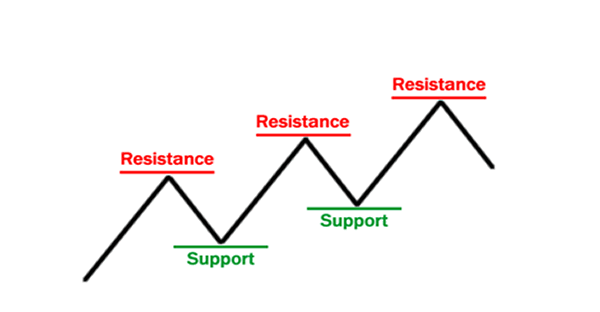1/ Understanding Support and Resistance:
• Support levels indicate where there will be a surplus of buyers.
• Resistance levels indicate where there will be a surplus of sellers.
• When the price moves up and then pulls back, the highest point reached before it pulled back is now resistance.
• When the price continues up again, the lowest point reached before it started back is now support.
2/ What is a Support:
• Support is the level at which demand is strong enough to absorb the supply.
• The price is likely to bounce back and moves up in the opposite direction.
• Support is a level where the demand from buyers is expected to be much higher than sellers.
3/ What is a Resistance:
• It is the opposite of a support level.
• It is a price point (ceiling) at which the stock price is not expected to rise any higher.
• Resistance is a price point at which there are more sellers than buyers in the market for a particular stock.
4/ Can support become a resitance and vice-versa:
• When the price passes through resistance, thereafter erstwhile resistance could potentially become support.
• Similarly, when prices pass through the support, thereafter erstwhile support could become a resistance.
5/ What happens when a Support or Resistance is tested multiple times:
• The more times S/R is tested, the weaker it becomes.
• When a support or resistance level breaks, the strength of the follow-through move depends on how strongly the broken S/R had been holding.
6/ How to trade using support-resistance logics:
• S/R logics can be used by bot breakout traders as well reversal traders.
7/ How to trade breakouts using S/R logics:
• Buy when the price breaks up through resistance with recent swing low as the SL.
• Sell when the price breaks down through support with recent swing high as the SL.
8/ How to trade reversals using S/R logics:
• Buy when the price falls towards support.
• Sell when the price rises toward resistance.
9/ Not exact numbers but always a zone:
• One thing to remember is that support and resistance levels are not exact numbers, they are always a zone.
10/ Practice is the key:
• You won't be able to define S/R in the live market unless you practice in the past charts.
• To train your eyes, you need to practice this across different time frames, and then you bare eyes could finally spot them.
If you enjoyed this thread here's another one:
https://t.co/PLr9MgRxfA
That's a wrap!
If you enjoyed this thread:
1. Follow us
@Adityatodmal &
@niki_poojary for more threads on Price action, Option Selling & Trading growth.
We've got you covered.
2. RT the first Tweet to share it with your audience.
I appreciate it!








